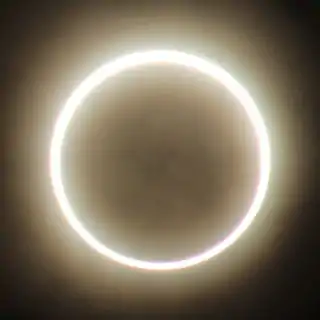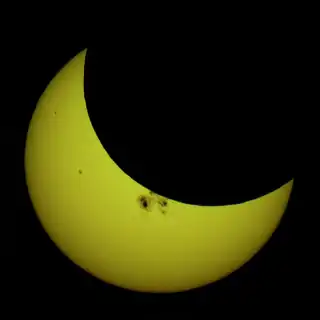Solar eclipse of September 23, 1987
An annular solar eclipse occurred on September 23, 1987. A solar eclipse occurs when the Moon passes between Earth and the Sun, thereby totally or partly obscuring the image of the Sun for a viewer on Earth. An annular solar eclipse occurs when the Moon's apparent diameter is smaller than the Sun's, blocking most of the Sun's light and causing the Sun to look like an annulus (ring). An annular eclipse appears as a partial eclipse over a region of the Earth thousands of kilometres wide. Annularity was visible in the Soviet Union (today's Kazakhstan), China (including Shanghai), southwestern Mongolia, Okinawa Islands of Japan except Kume Island and the southwestern tip of Kerama Islands, the Federal States of Micronesia, Papua New Guinea, Solomon Islands, Rotuma Islands of Fiji, Wallis Islands and West Samoa (the name changed to Samoa later). Occurring only 5 days after apogee (Apogee on September 18, 1987), the Moon's apparent diameter was relatively small.
| Solar eclipse of September 23, 1987 | |
|---|---|
 Map | |
| Type of eclipse | |
| Nature | Annular |
| Gamma | 0.2787 |
| Magnitude | 0.9634 |
| Maximum eclipse | |
| Duration | 229 sec (3 m 49 s) |
| Coordinates | 14.3°N 138.4°E |
| Max. width of band | 137 km (85 mi) |
| Times (UTC) | |
| Greatest eclipse | 3:12:22 |
| References | |
| Saros | 134 (42 of 71) |
| Catalog # (SE5000) | 9481 |
Observation
Five radio observation stations were present in China at the time of the eclipse, two of which were within the annularity, in Ürümqi and Shanghai respectively. A partial solar eclipse was observed from the other three, including one in Nanjing where the eclipse was close to annularity, and the rest two in Beijing and Kunming. The Department of Mathematics and Physics of the Chinese Academy of Sciences and the Chinese Astronomical Society held a meeting in Kunming in December 1986, deciding that on-site observation would be conducted at each station, among which the Shanghai Astronomical Observatory was considered to have the best location with a larger magnitude of the eclipse, longer duration and larger solar zenith angle. The Shanghai Astronomical Observatory conducted observations with seven different wave bands using a 25-metre radio telescope.[1] The Yunnan Astronomical Observatory located in Kunming also conducted a multi-band joint observation of the partial solar eclipse.[2]
The Chinese Research Institute of Radio Wave Propagation conducted observations with a high-frequency skywave radar located in Xinxiang on the southern limit of annularity. Uneven structure and motion were observed in the ionosphere, the highest operating frequency was found changed during the eclipse, and large-scale fluctuations continued after the eclipse.[3]
Related eclipses
Eclipses of 1987
- A hybrid solar eclipse on March 29.
- A penumbral lunar eclipse on April 14.
- An annular solar eclipse on September 23.
- A penumbral lunar eclipse on October 7.
Solar eclipses of 1986–1989
There were 8 solar eclipses between April 9, 1986 and August 31, 1989.
| Solar eclipse series sets from 1986–1989 | ||||||
|---|---|---|---|---|---|---|
| Ascending node | Descending node | |||||
| Saros | Map | Gamma | Saros | Map | Gamma | |
| 119 |  1986 April 9 Partial | −1.08215 | 124 |  1986 October 3 Hybrid | 0.99305 | |
| 129 | 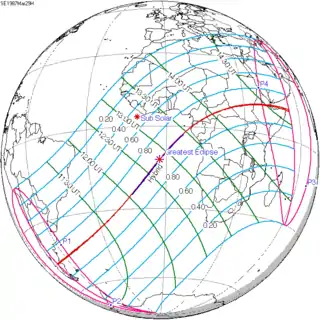 1987 March 29 Hybrid | −0.30531 | 134 |  1987 September 23 Annular | 0.27869 | |
| 139 |  1988 March 18 Total | 0.41879 | 144 |  1988 September 11 Annular | −0.46811 | |
| 149 | 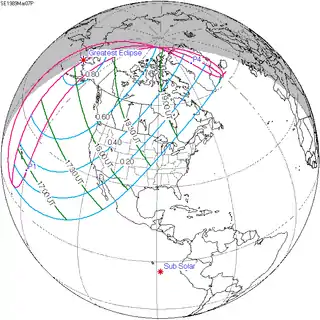 1989 March 7 Partial | 1.09815 | 154 | 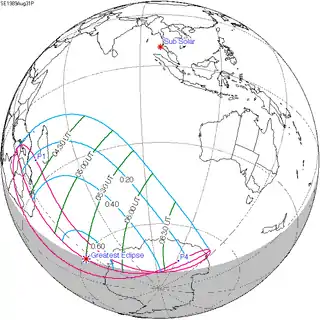 1989 August 31 Partial | −1.19279 | |
Saros 134
It is a part of Saros cycle 134, repeating every 18 years, 11 days, containing 71 events. The series started with a partial solar eclipse on June 22, 1248. It contains total eclipses from October 9, 1428 through December 24, 1554 and hybrid eclipses from January 3, 1573 through June 27, 1843, and annular eclipses from July 8, 1861 through May 21, 2384. The series ends at member 71 as a partial eclipse on August 6, 2510. The longest duration of totality was 1 minutes, 30 seconds on October 9, 1428. All eclipses in this series occur at the Moon’s descending node.[4]
| Series members 32–48 occur between 1801 and 2100: | ||
|---|---|---|
| 32 | 33 | 34 |
 June 6, 1807 |
 June 16, 1825 |
 June 27, 1843 |
| 35 | 36 | 37 |
 July 8, 1861 |
 July 19, 1879 |
 July 29, 1897 |
| 38 | 39 | 40 |
 August 10, 1915 |
 August 21, 1933 |
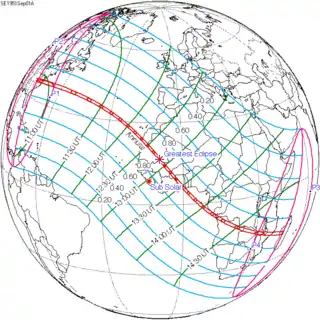 September 1, 1951 |
| 41 | 42 | 43 |
 September 11, 1969 |
 September 23, 1987 |
 October 3, 2005 |
| 44 | 45 | 46 |
 October 14, 2023 |
 October 25, 2041 |
 November 5, 2059 |
| 47 | 48 | |
 November 15, 2077 |
 November 27, 2095 | |
Metonic series
The metonic series repeats eclipses every 19 years (6939.69 days), lasting about 5 cycles. Eclipses occur in nearly the same calendar date. In addition, the octon subseries repeats 1/5 of that or every 3.8 years (1387.94 days). All eclipses in this table occur at the Moon's descending node.
| 21 eclipse events, progressing from north to south between July 11, 1953 and July 11, 2029 | ||||
|---|---|---|---|---|
| July 10–12 | April 29–30 | February 15–16 | December 4–5 | September 21–23 |
| 116 | 118 | 120 | 122 | 124 |
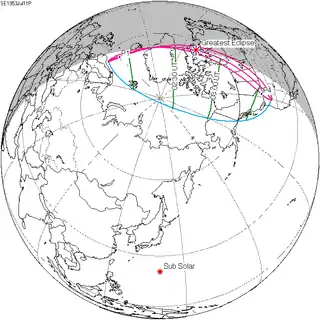 July 11, 1953 |
 April 30, 1957 |
 February 15, 1961 |
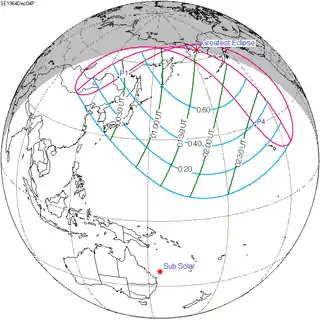 December 4, 1964 |
 September 22, 1968 |
| 126 | 128 | 130 | 132 | 134 |
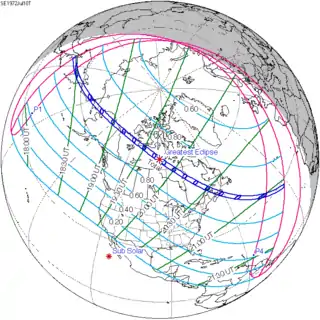 July 10, 1972 |
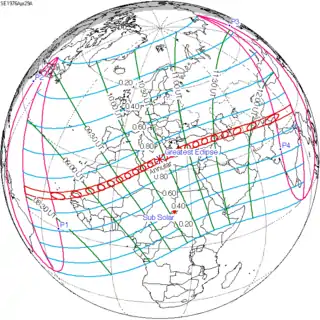 April 29, 1976 |
 February 16, 1980 |
 December 4, 1983 |
 September 23, 1987 |
| 136 | 138 | 140 | 142 | 144 |
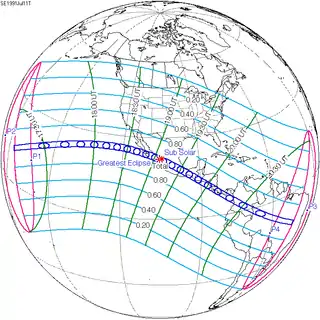 July 11, 1991 |
 April 29, 1995 |
 February 16, 1999 |
 December 4, 2002 |
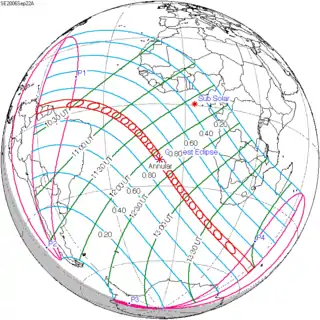 September 22, 2006 |
| 146 | 148 | 150 | 152 | 154 |
 July 11, 2010 |
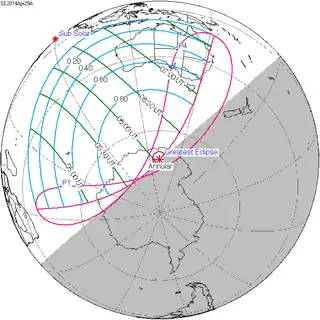 April 29, 2014 |
 February 15, 2018 |
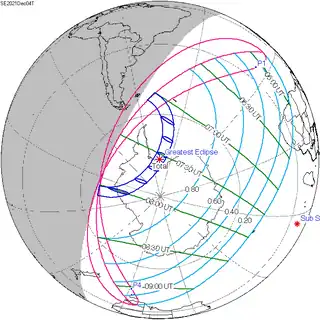 December 4, 2021 |
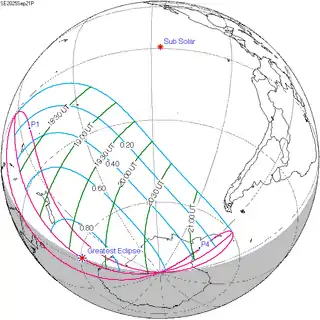 September 21, 2025 |
| 156 | 158 | 160 | 162 | 164 |
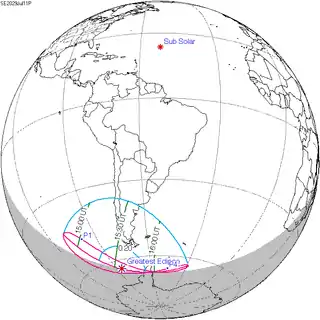 July 11, 2029 | ||||
Notes
- 纪树臣 季德盛 梁世光 (1988). "1987年9月23日沪台25米天线观测选题及方案". 云南天文台台刊 (4): 100–105.
- 纪树臣 杨荣邦 谢瑞祥 (1989). "1987年9月23日日偏食云台多波段联合观测". 云南天文台台刊 (3): 46–53.
- 焦培南 (1990). "1987年9月23日日环食的电离层波动现象". 地球物理学报. 33 (4): 391–398. Archived from the original on 21 July 2015.
- "NASA - Catalog of Solar Eclipses of Saros 134". eclipse.gsfc.nasa.gov.
References
- Earth visibility chart and eclipse statistics Eclipse Predictions by Fred Espenak, NASA/GSFC
.jpg.webp)
